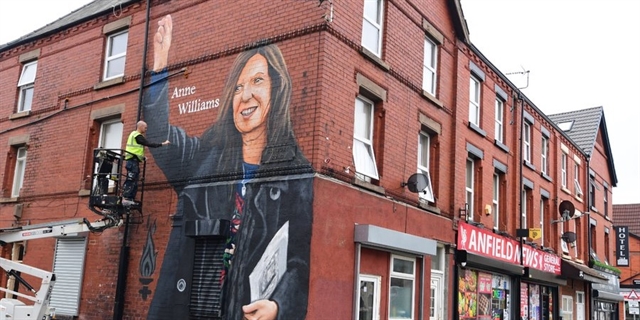 Sports
Sports

Pre-1989, supporters were treated like cattle at many grounds, herded into dilapidated and antiquated stadiums with little thought for safety.

|
| A mural of campaigner Anne Williams adorns a wall near to Liverpool Football Club. AFP Photo |
Paul Kennedy
This week at some Premier League grounds in the UK, a project was trialled to allow ‘safe-standing’ at a number of football matches.
Chelsea’s game against Liverpool on Sunday was one such fixture, with what was called railed seating installed in sections of the stadium to allow supporters to stand rather than sit to watch the match.
Manchester United, Manchester City, Tottenham and Cardiff were the other clubs in the pilot, which represents the realisation of a Conservative manifesto pledge for the 2019 General Election.
It marked the end of a blanket ban on standing at games in the top two tiers of English football which has been in place for more than 25 years.
Since August 1994, in the wake of the Hillsborough Disaster five years earlier that claimed the lives of 97 Liverpool supporters, teams in the top two leagues were required to provide all-seater accommodation.
So this move, albeit only a pilot scheme for now, is certainly radical to say the least.
Since the Hillsborough disaster, and the issuing of reports and enquiries that followed into improving safety for supporters, the game did change from a spectator's point of view.
Pre-1989, supporters were treated like cattle at many grounds, herded into dilapidated and antiquated stadiums with little thought for safety.
Today, football matches are a far more family affair, with modern stadiums a pleasure to visit.
So safe standing, if carried out correctly, could be a good move for the future of football.
Although purely a coincidence, I found it interesting that the pilot scheme was launched the same week a new four-part drama began on television in the UK called Anne.
The program is about a woman called Anne Williams, whose 15-year-old son, Kevin, died in the Hillsborough disaster.
I’ve spoken to Anne many times in my previous job as a reporter on the Liverpool Echo, an evening newspaper in the northwest of England.
She was always extremely dignified, determined, and a thoroughly decent human being who fought hard for a new inquiry into the disaster, levelling several legal attacks at the first Hillsborough inquest, questioning the credibility of its findings.
She formed a pressure group "Hope For Hillsborough", subsequently merging it into the "Hillsborough Justice Campaign", eventually becoming chair of the latter.
Sadly Anne died in 2013, three years before her hard work paid off when a second inquest ruled that her son, and the other 96 victims, were unlawfully killed due to grossly negligent failures by police and ambulance services to fulfil their duty of care.
We’ll never know what Anne’s opinion would have been on the reinstallation of standing sections at football grounds.
I hope they work and improve the atmosphere at stadiums to make football grounds a better all-round experience for the supporter.
But they must be closely monitored from all quarters to ensure safety is paramount and we never, ever see a repeat of what happened on April 15, 1989. VNS
Trailer for the documentary Anne which aired on television in the UK this week.